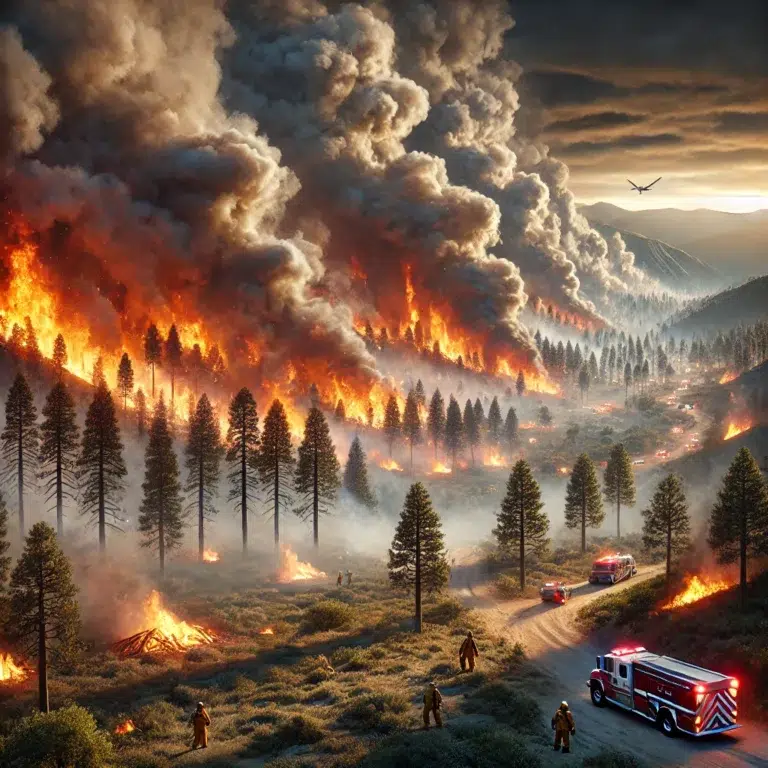Overview of the Southern California Wildfires January 2025
The Southern California Wildfires January 2025 have caused widespread devastation, particularly impacting regions across Los Angeles and Ventura Counties. These destructive wildfires in Southern California have been fueled by extreme Santa Ana winds, known for their dry and powerful gusts, and prolonged drought conditions that have left vegetation highly flammable. The combination of these environmental factors created an ideal scenario for rapid fire spread, resulting in significant property loss and threats to public safety. This article provides a comprehensive analysis, exploring the primary causes of the Southern California Wildfires January 2025, the extent of the damage inflicted, the ongoing efforts by firefighters and emergency services, and the current containment status as authorities work tirelessly to bring the situation under control.
For further details on wildfire prevention strategies, visit Ready for Wildfire.
Timeline and Affected Areas of the Southern California Wildfires January 2025
The Southern California Wildfires January 2025 began on January 7, 2025, following an extended period of dry weather and high winds, which contributed to the rapid spread of the fires. Major blazes such as the Palisades Fire, Eaton Fire, and Kenneth Fire erupted simultaneously, causing widespread destruction and overwhelming emergency response teams.
- Los Angeles County: Significant damage reported in Pacific Palisades, Altadena, and Pasadena, leading to mandatory evacuations and school closures.
- Ventura County: Areas along the Santa Clara River experienced extensive fire activity, with homes and critical infrastructure affected.
Efforts to control the Southern California Wildfires January 2025 have involved both local fire departments and federal resources working tirelessly to contain the blazes and protect residents.
For the latest updates on containment progress, visit National Interagency Fire Center.
Causes of the Southern California Wildfires January 2025
The Southern California Wildfires January 2025 were exacerbated by a combination of severe drought, high-speed Santa Ana winds, and climate change. Experts highlight that prolonged periods of below-average rainfall have significantly depleted soil moisture levels, leaving the region extremely vulnerable to fire outbreaks. The dry vegetation acted as a powerful fuel source, while the Santa Ana winds, known for their intensity and dry air, further accelerated the spread of the flames across vast areas. Climate change has played a pivotal role in amplifying these extreme weather patterns, increasing the frequency and severity of such events.
For expert insights on wildfire causes and climate impact, visit NASA Climate Change.
Causes of the Southern California Wildfires January 2025
The Southern California Wildfires January 2025 were exacerbated by a combination of severe drought, high-speed Santa Ana winds, and climate change. Experts highlight that prolonged periods of below-average rainfall have significantly depleted soil moisture levels, leaving the region extremely vulnerable to fire outbreaks. The dry vegetation acted as a powerful fuel source, while the Santa Ana winds, known for their intensity and dry air, further accelerated the spread of the flames across vast areas. Climate change has played a pivotal role in amplifying these extreme weather patterns, increasing the frequency and severity of such events.
For expert insights on wildfire causes and climate impact, visit NASA Climate Change.
Impact and Destruction
As of January 10, 2025, the Southern California Wildfires January 2025 have caused significant damage, including:
- Fatalities: 10 confirmed deaths
- Evacuations: 179,000 people displaced
- Structures Destroyed: Over 9,300 structures reported damaged
- Economic Damage: Estimated losses exceeding $50 billion
For ongoing updates and safety information, visit National Interagency Fire Center.
Causes of the Southern California Wildfires January 2025
The Southern California Wildfires January 2025 were exacerbated by a combination of severe drought, high-speed Santa Ana winds, and climate change. Experts highlight that prolonged periods of below-average rainfall have significantly depleted soil moisture levels, leaving the region extremely vulnerable to fire outbreaks. The dry vegetation acted as a powerful fuel source, while the Santa Ana winds, known for their intensity and dry air, further accelerated the spread of the flames across vast areas. Climate change has played a pivotal role in amplifying these extreme weather patterns, increasing the frequency and severity of such events.
For expert insights on wildfire causes and climate impact, visit NASA Climate Change.
Impact and Destruction
As of January 10, 2025, the Southern California Wildfires January 2025 have caused significant damage, including:
- Fatalities: 10 confirmed deaths
- Evacuations: 179,000 people displaced
- Structures Destroyed: Over 9,300 structures reported damaged
- Economic Damage: Estimated losses exceeding $50 billion
For ongoing updates and safety information, visit National Interagency Fire Center.
Firefighting Efforts and Government Response
California Governor Gavin Newsom has deployed 900 firefighters to combat the Southern California Wildfires January 2025, supported by federal aid and aerial resources. Emergency response teams are working around the clock to contain the fires and prevent further devastation. Additionally, temporary shelters have been established for displaced residents, and financial assistance is being provided to those affected by the destruction.
For federal response details, visit FEMA Official Site.
Causes of the Southern California Wildfires January 2025
The Southern California Wildfires January 2025 were exacerbated by a combination of severe drought, high-speed Santa Ana winds, and climate change. Experts highlight that prolonged periods of below-average rainfall have significantly depleted soil moisture levels, leaving the region extremely vulnerable to fire outbreaks. The dry vegetation acted as a powerful fuel source, while the Santa Ana winds, known for their intensity and dry air, further accelerated the spread of the flames across vast areas. Climate change has played a pivotal role in amplifying these extreme weather patterns, increasing the frequency and severity of such events.
For expert insights on wildfire causes and climate impact, visit NASA Climate Change.
Impact and Destruction
As of January 10, 2025, the Southern California Wildfires January 2025 have caused significant damage, including:
- Fatalities: 10 confirmed deaths
- Evacuations: 179,000 people displaced
- Structures Destroyed: Over 9,300 structures reported damaged
- Economic Damage: Estimated losses exceeding $50 billion
For ongoing updates and safety information, visit National Interagency Fire Center.
Firefighting Efforts and Government Response
California Governor Gavin Newsom has deployed 900 firefighters to combat the Southern California Wildfires January 2025, supported by federal aid and aerial resources. Emergency response teams are working around the clock to contain the fires and prevent further devastation. Additionally, temporary shelters have been established for displaced residents, and financial assistance is being provided to those affected by the destruction.
For federal response details, visit FEMA Official Site.
Conclusion and Key Takeaways
The Southern California Wildfires January 2025 serve as a stark reminder of the challenges posed by climate change and inadequate preparedness. Continued vigilance and proactive community support remain essential to mitigate future wildfire threats. Investing in early detection systems, enhancing firebreak strategies, and prioritizing climate resilience will be crucial in safeguarding vulnerable areas from further devastation.
For resources on wildfire preparedness, visit Ready.gov Wildfire Preparedness.
Causes of the Southern California Wildfires January 2025
The Southern California Wildfires January 2025 were exacerbated by a combination of severe drought, high-speed Santa Ana winds, and climate change. Experts highlight that prolonged periods of below-average rainfall have significantly depleted soil moisture levels, leaving the region extremely vulnerable to fire outbreaks. The dry vegetation acted as a powerful fuel source, while the Santa Ana winds, known for their intensity and dry air, further accelerated the spread of the flames across vast areas. Climate change has played a pivotal role in amplifying these extreme weather patterns, increasing the frequency and severity of such events.
For expert insights on wildfire causes and climate impact, visit NASA Climate Change.
Impact and Destruction
As of January 10, 2025, the Southern California Wildfires January 2025 have caused significant damage, including:
- Fatalities: 10 confirmed deaths
- Evacuations: 179,000 people displaced
- Structures Destroyed: Over 9,300 structures reported damaged
- Economic Damage: Estimated losses exceeding $50 billion
For ongoing updates and safety information, visit National Interagency Fire Center.
Firefighting Efforts and Government Response
California Governor Gavin Newsom has deployed 900 firefighters to combat the Southern California Wildfires January 2025, supported by federal aid and aerial resources. Emergency response teams are working around the clock to contain the fires and prevent further devastation. Additionally, temporary shelters have been established for displaced residents, and financial assistance is being provided to those affected by the destruction.
For federal response details, visit FEMA Official Site.
Conclusion and Key Takeaways
The Southern California Wildfires January 2025 serve as a stark reminder of the challenges posed by climate change and inadequate preparedness. Continued vigilance and proactive community support remain essential to mitigate future wildfire threats. Investing in early detection systems, enhancing firebreak strategies, and prioritizing climate resilience will be crucial in safeguarding vulnerable areas from further devastation.
For resources on wildfire preparedness, visit Ready.gov Wildfire Preparedness.
Contact Us
If you have any questions, feedback, or collaboration inquiries, we’re here to help! Reach out to us directly via email at info@postscroll.blog or visit our official contact page for more details.
FAQs
-
▶ What caused the January 2025 wildfires?
The wildfires were primarily caused by extreme Santa Ana winds, dry vegetation, and ongoing drought conditions exacerbated by climate change.
-
▶ Which areas were most affected?
Los Angeles and Ventura counties have been significantly impacted, with Pacific Palisades, Altadena, and Pasadena being the hardest hit.
-
▶ What is the current status of the wildfires?
As of January 10, 2025, the wildfires are still active with partial containment, and firefighting efforts are ongoing.
-
▶ How can residents stay safe during wildfires?
Residents should follow evacuation orders, stay informed via official channels, and have emergency kits prepared.
-
▶ What steps are being taken to control the fires?
Over 900 firefighters, federal aid, and aerial resources have been deployed for containment and rescue operations.




Пътешествие до Гран Канария: почивка на мечтите, къде да отпочинете на острова.
Почивка на плажовете на Гран Канария: насладете се на слънцето и морето.
Гран Канария за гурмани: опитайте най-добрите ястия на острова.
Екскурзии на Гран Канария: открийте историята на острова.
Гран Канария: най-добрите спа центрове за пълно расслабление.
Почивка на Гран Канария: забавления за цялото семейство.
Почивка в Гран Канария на добри цени [url=http://www.bohemia.bg]http://www.bohemia.bg[/url] .
Купить Хавал – только у нас вы найдете разные комплектации. Быстрей всего сделать заказ на хавал джолион комплектации и цены можно только у нас!
[url=https://jolion-ufa1.ru]хавейл джолион цена и комплектация[/url]
хавал джулион цена – [url=http://jolion-ufa1.ru]https://www.jolion-ufa1.ru/[/url]